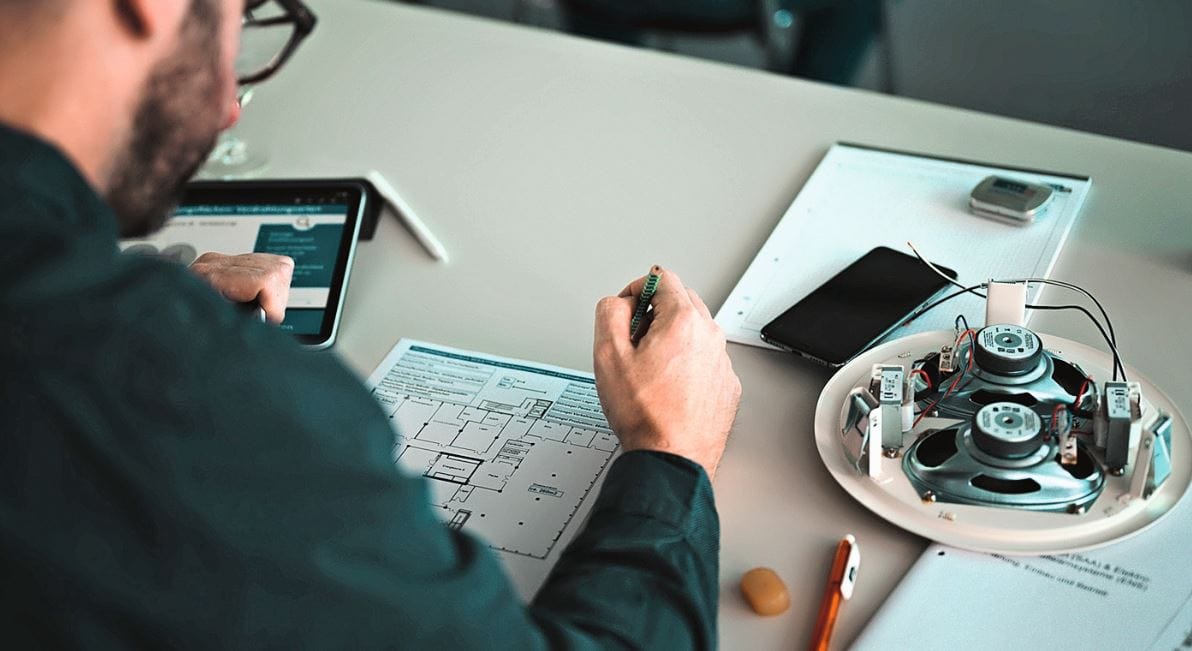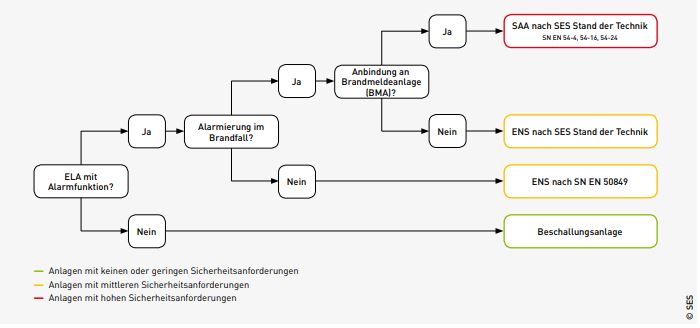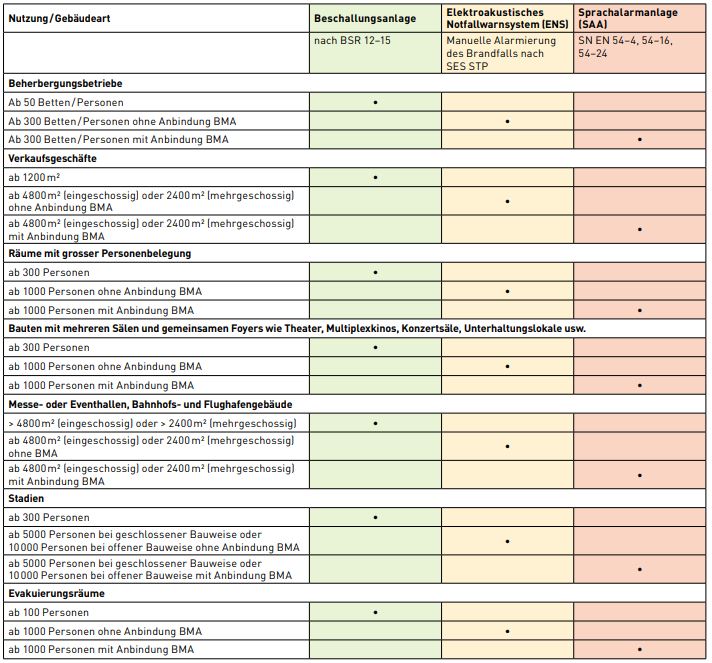SAA: New SES Guideline
In more complex structures or in buildings where people who are unfamiliar with the location or who have not been instructed are present, evacuation is often supported by so-called evacuation systems. If these systems comply with the applicable SES directive, they are technically referred to as voice alarm systems (SAA) or electroacoustic emergency warning systems (ENS).

The two definitions of the terms SAA (voice alarm systems) and ENS (electroacoustic emergency warning systems) are encountered repeatedly in the SES guideline and it is important to understand the distinction according to SES (Association of Swiss Installers of Security Systems).
In general, both designations refer to electro-acoustic loudspeaker systems that inform people in the building via loudspeakers and/or other signal transmitters in the event of an emergency or during normal operation and encourage them to rescue themselves or to behave correctly in the event of an emergency. Only the normative and safety requirements distinguish these types of systems. SAA have the highest safety requirement. They must comply with the EN-54 standard series and are usually part of a fire alarm system (BMA). This means that an SAA takes over part of the BMA functions, specifically the function of the acoustic sounders (alarm horn). According to the SES guideline, a so-called security level must be defined for SAA, which specifies how high the failure safety must be.

The term "public address system" describes a system that does not have to meet any specific safety requirements and therefore does not necessarily achieve the protection objective. For this reason, this type of system is not dealt with further in the SES guideline.
First publication of the SES guideline for SAA & ENS in 2017.
The SAA and ENS security area has been part of the SES association since 2015. Originally, this area was part of the BMA working group, but it became more and more important. For this reason, a separate Technical Working Commission (TAK) was established, which took on the initial creation of the SES guideline for SAA & ENS. This was followed about two years later by the initial publication of the SES guideline for this area. The responsible commissions of the Association of Cantonal Fire Insurers (VKF) approved and recognized the guideline shortly thereafter as a "state of the art" paper.
The introduction of a separate guideline for the trade provided great relief in the market. This meant that quality requirements could be met from now on.

Revision of the SES guideline after about three years
After publication, it quickly became clear that the guideline had great added value for the industry. It was increasingly used by planners and other companies involved in tenders and projects. It provides greater clarity on how systems are to be designed and implemented, and has since served as a guide for authorities, planners, specialists, installers and operators. However, it also became clear that certain points left too much room for interpretation or were not explained in sufficient detail, whereupon the TAK decided to revise the guideline.
Before the revision started, an SES acceptance protocol was published, which can be used as a guide when accepting systems. Since then, it has been easier for designers and installers to have the quality of systems checked. They can refer to the document without much effort or ask the installer to do so.
In June 2021, some three years after the initial publication, the time had come and the second version of the SES Guideline for SAA & ENS was published and recognized by the VFK as a "state of the art" paper. It is worth mentioning the close cooperation between SES and VKF, which resulted in the document having the desired content for all parties involved.
What has changed in the revised policy?
The guideline was structured better and the two plant types SAA and ENS were divided into separate chapters. In addition, individual points have been defined more clearly. Two changes are particularly noteworthy:
- The SAA asset type generally remained the same, but the ENS asset type was divided into two categories:
"ENS according to SN EN 50849": corresponds to the original description of an ENS from the 2017 directive. Alarming in the event of fire is not permitted with this type of system. - "ENS according to SES guideline": With this type of system, the alarming of a fire case is permissible, provided that this is not carried out automatically by the fire alarm system (BMA). The system must therefore not take over any functions of the fire alarm system. In addition, few safety requirements have been extended compared to the type according to SN EN 50849.
Two graphics were added to show which types of system should be used for which types of building. After consultation with the VFK, it was decided that this information should be reproduced in the SES guideline and that the VKF guideline (BR 12-15), which deals with the subject of Evak, should not be adapted.

Further procedure of the Technical Working Committee SAA & ENS
Since the publication of the revised version, this has gained further importance in the industry and is increasingly used in submissions as well as projects. It could also be noted that the circle of experts in this field is steadily increasing. During the past months, the TAK has collected a wide variety of very valuable feedback on the new SES guideline, which is now being carefully reviewed.
Following the evaluation, the most important questions are to be addressed in FAQ. It would also be conceivable to specify this in the guideline, provided that the scope of change is within the bounds of possibility.
Through these measures, the TAK would like to further increase clarity and comprehensibility in the area of SAA & ENS and establish the guideline even more as a standard.
Training at the STFW
Since 2020, the subject of "Evak and voice alarming" has been represented at the Swiss Technical College Winterthur (STFW) in the form of a one-day basic course. The course provides participants with the basic knowledge of this specialist area as well as further information in the area of planning, project planning, execution and maintenance of systems and refers in each case to the valid SES guideline of the area. The course is therefore ideally suited for all persons who come into contact with the specialist area of SAA & ENS in their work. Questions of all kinds will be answered competently and according to the current state of knowledge by the expert speakers.
SES fact sheet
A recently published leaflet on "Alarm and fault sequences of fire alarm systems" was prepared in cooperation between TAK BMA and TAK SAA and describes the extent to which an SAA can take over the functions of the BMA. The monitoring of the functions and the general communication between the two systems is also explained.
This technical article appeared in the printed edition SicherheitsForum 3-2022.
You want to read the articles of this issue? Then close right now here a subscription.









